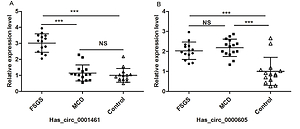Current issue
Archive
Manuscripts accepted
About the Journal
Editorial office
Editorial board
Section Editors
Abstracting and indexing
Subscription
Contact
Ethical standards and procedures
Most read articles
Instructions for authors
Article Processing Charge (APC)
Regulations of paying article processing charge (APC)
RESEARCH PAPER
Hsa_circ_0001461 as a novel biomarker in patients with primary focal segmental glomerulosclerosis
1
Guangzhou Women and Children's Medical Center, China
Submission date: 2020-09-25
Final revision date: 2021-05-08
Acceptance date: 2021-05-08
Online publication date: 2021-05-15
Corresponding author
KEYWORDS
TOPICS
ABSTRACT
Introduction:
Circular RNAs (circRNAs), a novel class of non-coding RNAs, have been implicated in various diseases and are considered to play an important role in physiological and pathological processes. We aimed to profile renal circRNA in children with primary focal segmental glomerulosclerosis (FSGS) and predict the potential mechanism underlying the pathogenesis of FSGS.
Material and methods:
A global circRNA expression analysis was performed in renal tissues from patients with FSGS (n=3) and controls (n=3). Quantitative real-time polymerase chain reaction (qRT-PCR) was conducted to validate the expression levels of three circRNAs in a cohort of 44 patients with FSGS, 44 age-matched healthy controls, and 15 patients with minimal change disease (MCD).
Results:
A total of 152 circRNAs were differentially expressed in patients with FSGS compared with controls. Hsa_circ_0001461 and hsa_circ_0000605 were significantly increased in patients with FSGS compared with controls, as determined by qRT-PCR (p < 0.001). The receiver operating characteristic (ROC) curve areas of hsa_circ_0001461 and hsa_circ_0000605 were 0.948 and 0.934, respectively. Hsa_circ_0001461 was significantly elevated in patients with FSGS compared with those with MCD and was correlated with 24 h urinary protein in patients with FSGS (r = 0.732, p < 0.001). Bioinformatics analysis predicted mir-30a interaction with hsa_circ_0001461. Mir-30a was negatively correlated with the renal hsa_circ_0001461 level (r = -0.90, p < 0.001).
Conclusions:
Hsa_circ_0001461 is identified as a novel biomarker in children with FSGS and might provide insights into the mechanism of FSGS pathogenesis.
Circular RNAs (circRNAs), a novel class of non-coding RNAs, have been implicated in various diseases and are considered to play an important role in physiological and pathological processes. We aimed to profile renal circRNA in children with primary focal segmental glomerulosclerosis (FSGS) and predict the potential mechanism underlying the pathogenesis of FSGS.
Material and methods:
A global circRNA expression analysis was performed in renal tissues from patients with FSGS (n=3) and controls (n=3). Quantitative real-time polymerase chain reaction (qRT-PCR) was conducted to validate the expression levels of three circRNAs in a cohort of 44 patients with FSGS, 44 age-matched healthy controls, and 15 patients with minimal change disease (MCD).
Results:
A total of 152 circRNAs were differentially expressed in patients with FSGS compared with controls. Hsa_circ_0001461 and hsa_circ_0000605 were significantly increased in patients with FSGS compared with controls, as determined by qRT-PCR (p < 0.001). The receiver operating characteristic (ROC) curve areas of hsa_circ_0001461 and hsa_circ_0000605 were 0.948 and 0.934, respectively. Hsa_circ_0001461 was significantly elevated in patients with FSGS compared with those with MCD and was correlated with 24 h urinary protein in patients with FSGS (r = 0.732, p < 0.001). Bioinformatics analysis predicted mir-30a interaction with hsa_circ_0001461. Mir-30a was negatively correlated with the renal hsa_circ_0001461 level (r = -0.90, p < 0.001).
Conclusions:
Hsa_circ_0001461 is identified as a novel biomarker in children with FSGS and might provide insights into the mechanism of FSGS pathogenesis.
Share
RELATED ARTICLE
We process personal data collected when visiting the website. The function of obtaining information about users and their behavior is carried out by voluntarily entered information in forms and saving cookies in end devices. Data, including cookies, are used to provide services, improve the user experience and to analyze the traffic in accordance with the Privacy policy. Data are also collected and processed by Google Analytics tool (more).
You can change cookies settings in your browser. Restricted use of cookies in the browser configuration may affect some functionalities of the website.
You can change cookies settings in your browser. Restricted use of cookies in the browser configuration may affect some functionalities of the website.



